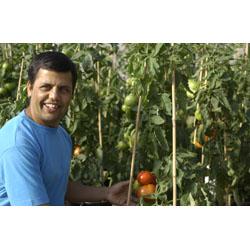Study findings may pay dividends for CQ crop producers
Published on 21 August, 2003
A research study conducted through Central Queensland University has found sub-surface drip irrigation using aerated water can lead to significant water savings and produce better crop yields in the heavy clay soils of the Central Queensland region.
School of Biological and Environmental Sciences Plant Sciences Group Doctoral Fellow Surya Prasad Bhattarai conducted his experiments in CQU’s Plant Sciences Group at Rockhampton on a range of crops, including vegetable soybean, tomato and cotton.
 In a presentation to CQU, Mr Bhattarai said aeration of the root zone was performed during the experiments using hydrogen peroxide at 50 per cent solution and at the rate of one millilitre per litre of irrigation water, and air injection to mix air at the rate of 12 per cent by volume of water.
In a presentation to CQU, Mr Bhattarai said aeration of the root zone was performed during the experiments using hydrogen peroxide at 50 per cent solution and at the rate of one millilitre per litre of irrigation water, and air injection to mix air at the rate of 12 per cent by volume of water.
Mr Bhattarai said both of these treatments produced similar results, suggesting that the effect of aeration was due to oxygen and not the other gases.
“Air injection for aeration has been found to be a more practical approach for the bigger industrial scale as the cost for aeration with hydrogen peroxide is costly and other long-term effects of hydrogen peroxide in the soil are not fully understood,” he said.
His experiments also showed the aeration of vegetable soybean significantly increased the yield and water use efficiency by 96 per cent and 72 per cent respectively.
“Likewise, the effect of aeration on water use efficiency and the yield of cotton lint was recorded to increase at the range of 27 per cent compared to control, irrespective of the soil moisture level,’’ he said.
Mr Bhattarai said a current experiment with tomato was also showing a significant difference between the aerated and non-aerated plots in relation to the growth, development and yield of tomato.
“In the face of severe shortage of water for irrigation, in the one hand, and high rate of loss on the conventional irrigation methods on the other, it is a very high time for the adoption of water saving irrigation methods,’’ he said.
“Drip irrigation (surface and subsurface) has proved to be efficient in terms of reducing such losses. The drip irrigation not only minimises such losses but also allows for the supply of aerated water directly in to the root zone of crop.’’ Mr Bhattarai said the technique of soil aeration, coupled with subsurface drip irrigation, could have wide application from the home garden through to agricultural industries in Central Queensland and throughout heavy clay soil areas of Australia.
Though, he said the costs were considerable, making it viable only to producers in the long-term where increased yield would offset the costs.

